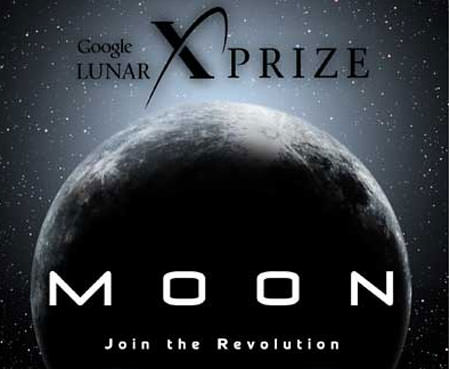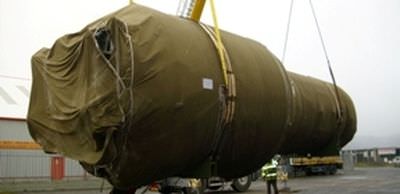OK, SpaceX, you’ve got us intrigued. This video released today by SpaceX says something “big” is coming on April 5, 2011. No embargoes, either!
Google Lunar X-Prize’s ‘college team’ gaining steam, attention and support
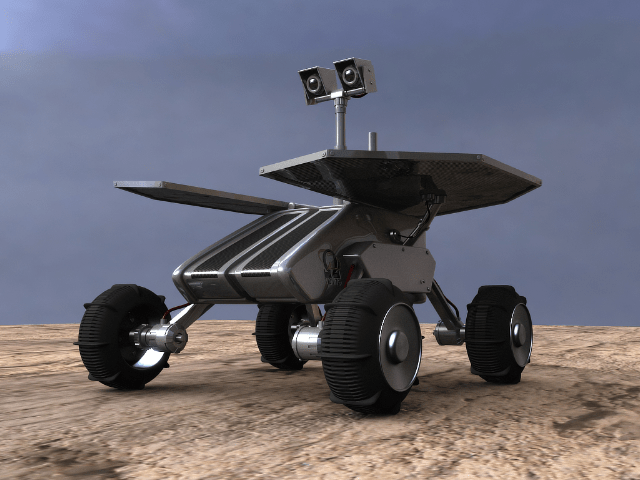
[/caption]
ORLANDO – The Google Lunar X-PRIZE (GLXP) recently announced the 29 official teams that will be vying for the $30 million grand prize. One group in particular stands out amongst the list however – Omega Envoy. This team is comprised primarily by college students from the University of Central Florida, working on engineering and other degrees. However, while they may be relatively young, they have drawn the attention of the media, numerous sponsors, NASA and the space industry.
NASA has inked a deal with the tiny band of potential explorers to purchase data from their spacecraft. The space agency awarded the Innovative Lunar Demonstration Data contract to Omega Envoy. This contract is worth up to $10 million. However, while this contract and the growing list of sponsors is impressive, the feat that the team is trying to accomplish is daunting. What they are attempting to do, only nations have done before.
The GLXP requires that to win, the team must safely land a robot on the lunar surface, have it travel 1,500 feet and send back both images and data to Earth. Given the fact that, to date, only the U.S. and Russia have accomplished this before – this is no small task.

The Google Lunar X-PRIZE is another effort by the X-PRIZE Foundation. The impetus behind this organization is to accelerate space exploration efforts much in the same way that the Orteig Prize accelerated air travel in the 20th Century. That prize was a paltry (by today’s standards) $25,000 for the first person to fly non-stop from New York to Paris (or vice-versa). Its winner, Charles Lindbergh, would go down in history as one of the most famous aviators of all time. It is with this premise in mind that the X-PRIZE Foundation works to inspire today’s explorers and innovators.
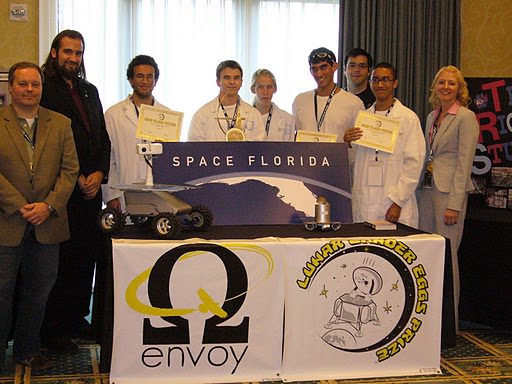
For the original Ansari X-PRIZE it took an established (if somewhat outside of the mainstream) aerospace company with years of experience to finally accomplish the objectives laid out. Scaled Composites, renowned for their kit aircraft; successfully sent a manned spacecraft into sub-orbital space, returned safely and then sent the same spacecraft, SpaceShipOne; back into space within the required two weeks.
The non-profit organization that oversees all aspects of Omega Envoy, Earthrise Space Inc. (ESI), works to provide services to private companies, government agencies, as well as educational institutions that currently have the resources to explore space and are looking for low cost products that will accomplish their requirements. They feel that this will enhance the accessibility of technology and increase educational interest amongst the workforce that drives the space.
“Aside from the GLXP, ESI intends to continuously schedule lunar deliveries for scientific payloads and robotics,” said Earthrise Space Institute’s Project Director Ruben Nunez. “Other mission objectives for Omega Envoy entail the visual feedback of a scientific payload that will analyze the lunar terrain.”

Through the Google Lunar X-PRIZE and government contracts such as the contract with NASA, it is hoped that this initiative will enable the creation of a new economic system to support lunar exploration as well as Technology Readiness Level (TRL) advancement of innovative, commercial space systems.
“I am fortunate in that I had the opportunity to witness what Omega Envoy is capable of producing when I field tested their prototype rover during the 2009 FMARS (Flashline Mars Arctic Research Station) Expedition,” said Joseph Palaia 4Frontiers’ Vice President. “There is little doubt in my mind that this team is fully capable of accomplishing the objectives laid out in the GLXP.”

When Will We Return to the Moon and Who Will it Be?
At the end of the movie “Apollo 13,” when the character of Jim Lovell says “I look up at the Moon and wonder, when will we be going back, and who will that be?” he probably didn’t have anything like the Google Lunar X PRIZE in mind. Similarly, when the GLXP was announced back in 2007, the founders had no idea that nearly 30 teams would be vying for the $30 million in incentive prizes to return to the Moon’s surface with a robotic craft.
Will Pomerantz, the former Senior Director of Space Prizes from the X PRIZE Foundation recalled an advisory committee meeting several years ago before the prize was announced. “We went around the room and asked everyone to estimate how many teams are going to compete in this,” Pomerantz said. “The answers ranged from zero on the low end to maybe a dozen or fifteen at the absolute max and that probably came either for myself or from Peter Diamandis, our founder. The fact that we have almost thirty blows us away, and we couldn’t be more thrilled.”
The X PRIZE Foundation recently announced the official roster of 29 teams that will attempt to send a robot to the Moon that travels at least 500 meters and transmit video, images, and data back to the Earth. The organization says this signifies a “new era of exploration’s diverse and participatory nature.”
The teams are headquartered all over the world — seventeen different headquarter nations — and most of the teams are actually multinationals, so team members are working in almost seventy different countries on every continent except for Antarctica.
“This is going to be the first time anything has been on the lunar surface since the final Soviet robotic mission in 1976,” Pomerantz said and those of us in the states really haven’t seen any data directly from the lunar surface since 1972, so we think that there’s at a ton to be learned scientifically, but also there’s a huge inspirational factor there for people to be able to see those images again.”
Of course, the robotic missions being designed are much less complicated and expensive than a human mission to the Moon.
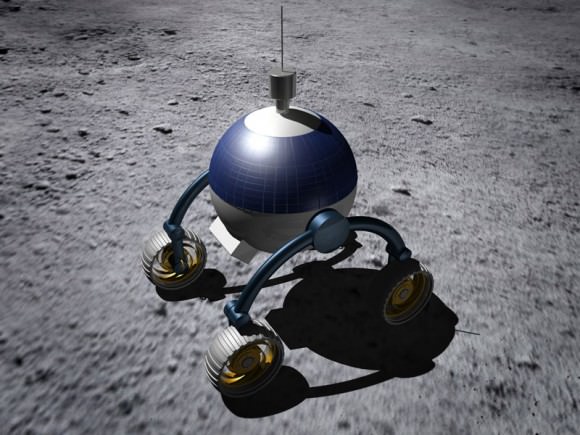
The concepts range from snake-like robots that slither along the surface to ball-shaped vehicles that can shift their mass internally move along the lunar surface to small robotic vehicles – “not too much bigger than the cell phone you’ve got your pocket,” Pomeranzt said – to rovers that look very much NASA- or ESA-designed vehicles. Others won’t rove at all, but reignite their engines to take off and fly to another location. This may allow them to explore totally different types of terrain that is totally inaccessible to a rover.
The landing sites that the various teams are shooting for differ as well. “Essentially everyone is going on the near side for obvious communication reasons,” Pomerantz said. “Almost everyone is going in a fairly low latitude and going in the equatorial zones.”
There are bonus prizes of several million additional dollars for teams that can go to particular sites, such the South Pole, where they could possibly confirm the findings at the LCROSS impact site, or if they go back to visit one of the Apollo landing sites or one of the sites of a non-human mission.
“I know that causes some concern for some people,” Pomerantz said. “People very rightly want to make sure that we are being respectful of those treasured historical sites. But I think it is important to recognize that no one values those sites more than the men and women around the world who are dedicating their careers to getting back to the surface of the Moon. They absolutely understand that those are our valuable treasures that need to be respected but they also understand that there’s an enormous amount to be gained from going back and respectfully revisiting the. There is some very interesting science that we can do by going back and seeing how the site and how those materials have changed over the past forty years.”
Why offer a prize to return to the Moon?
“We want to open the space frontier in the way similar to what we did it for the first X PRZE, the Ansari X PRIZE,” Pomerantz said. “We want to make space exploration and lunar exploration in particular radically cheaper. We think when you create a much lower price point, when you bring the price of missions down to a tenth to what it historically has been or even a hundredth of what it historically has been, you’re opening it up to a huge variety of new customers, new science communities, new industries that just can’t exist at the current price points.”
All the teams have to come up with their own funding.
“This is really a cash on delivery kind of model,” Pomerantz said. “But we don’t want to pay people to try. There are enough other people out there that are funding people to try new things. We want to reward people upon success. That means that no matter how crazy an idea might seem today, if it happens to be the best one, then we’ll reward it.”
Right now, the prize money is set to expire by the end of 2015, but the GLXP organizers are quite confident that at least one of the 29 teams will successfully reach the Moon before then. And obviously, NASA is confident, as well, as the space agency is offering a program called the Innovative Lunar Demonstration and Data Program, which is essentially $30 million dollars worth of data purchases from commercial efforts that reach the Moon.
“This is NASA saying for first time ever we are able to buy data about conducting lunar missions and about the Moon itself, rather than having to go out and pay for the acquisition of that data directly on the hopes that it will work,” Pomerantz said. “This is a great buy for NASA and I think they are getting a tremendous value and is a great way for teams to show their investors and supporters that, hey we’ve got a willing customer here. And NASA is not afraid of us; this isn’t an ‘us versus them competition.’ This is an area where our success is their success and vice versa.
Pomerantz is leaving the X PRIZE Foundation to begin work with Virgin Galactic. “I’ve loved every minute of being with the X PRIZE, but this was an opportunity just too good to pass up and I’m extremely excited about it even though I’m sad to be leaving X PRIZE.”
For more information about GLXP, see their website. See the complete roster of competing teams here.
Listen to an interview with Pomerantz on the 365 Days of Astronomy website.
Astronomy Cast Ep. 214: Space Tourism

Have you ever wanted to go to space, but lacked the… everything… to be an astronaut? A whole new industry of space tourism will take you where you need to go. There are new companies offering zero-G flights, sub-orbital flights, and there have even been paying customers who have gone into orbit. Is this going to be space travel for the rest of us?
Click here to download the episode.
Or subscribe to: astronomycast.com/podcast.xml with your podcatching software.
Scientists to go Suborbital for Research
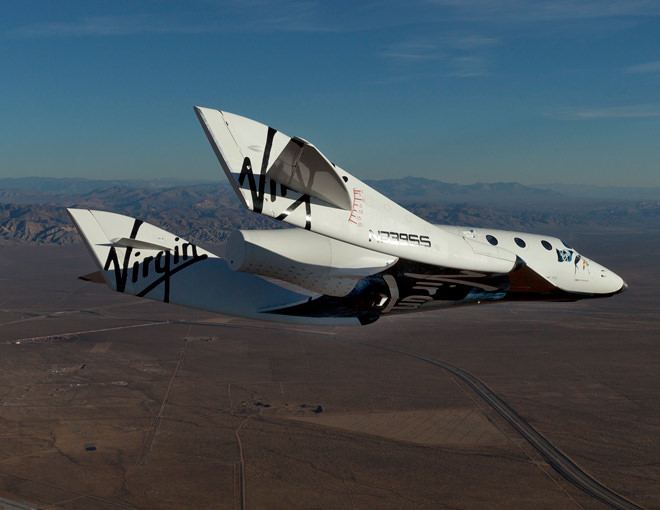
[/caption]
Think again if you believe the suborbital space market is exclusively for well-heeled tourists. The Southwest Research Institute has just inked deals with Virgin Galactic and XCOR Aerospace to fly up to 17 scientific research flights. Three scientists, including Dr. Alan Stern, former head of the Science Mission Directorate at NASA and current New Horizons Principal Investigator, will become some of the first scientists to fly on a commercial spacecraft to conduct scientific research. They will fly on board Virgin’s SpaceShipTwo and XCOR’s Lynx.
“We’re another step closer to the era of routine ‘field work’ in space research,” said Dr. Dan Durda, another SwRI scientist who is scheduled to fly. “More and more researchers will soon fly with their own experiments in space, and do it regularly enough to allow the important advances that come with iterative investigations. I’m looking forward to that future and helping it become a reality.”
“We at SwRI are very strong believers in the transformational power of commercial, next-generation suborbital vehicles to advance many kinds of research,” said Stern. “We also believe that by putting scientists in space with their experiments, researchers can achieve better results at lower costs and a higher probability of success than with many old-style automated experiments.”

The spacecraft will fly on short suborbital flights to altitudes greater than 107,000 meters (350,000 feet) above the internationally recognized boundary of space.
At least two SwRI researchers will fly on SpaceShipTwo, which can carry two pilots and up to six researchers, and later, there will be a dedicated six-seat research mission SS2. SpaceShipTwo’s large cabin enables researchers to work together in an “out-of-seat” micro gravity environment.
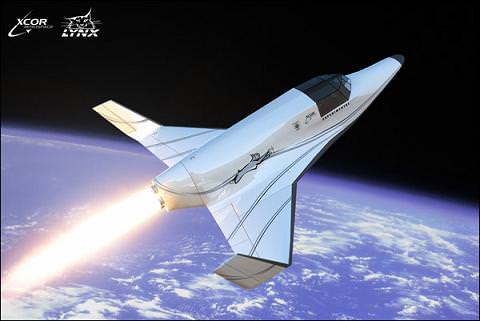
SwRI researchers will also fly at least six high altitude missions aboard XCOR Corporation’s Lynx Mark I high-altitude rocket plane, which carries a pilot and a single researcher at altitudes up to 200,000 feet. Lynx I is currently in development, with test flights expected to begin in 2012.
The types of research planned includes biomedical, microgravity and astronomical imaging experiments.
Besides Stern andDurda, Dr. Cathy Olkin is also scheduled to fly on the research flights. All three scientists selected have trained for suborbital spaceflight aboard zero-G aircraft, in NASTAR centrifuges and aboard Starfighter F-104 jet fighters in the last year.
“This is a historic moment for spaceflight,” said Commercial Spaceflight Federation Executive Director John Gedmark. “A scientific research institution is spending its own money to send its scientists to space. I expect that these scientists will be the first of many to fly to space commercially. As the scientific community realizes that they can put payloads and people into space at unprecedented low costs, the floodgates will open even wider.”
Sources: SwRI, Commercial Spaceflight Federation
Forever Endeavour: USA has Plan to Continue Flying Space Shuttles
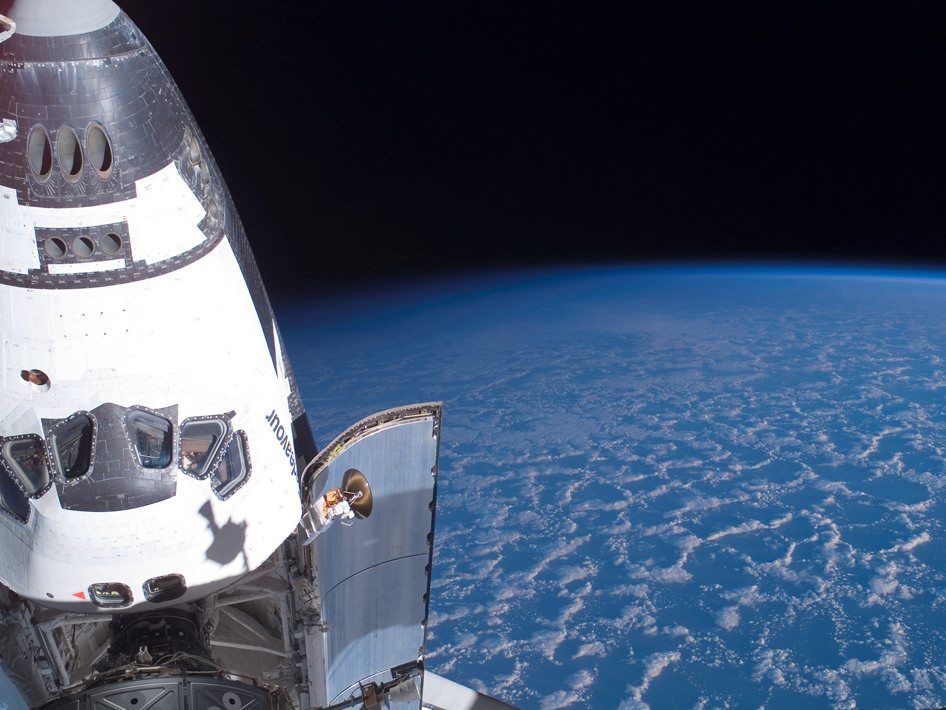
[/caption]
She is the youngest orbiter in NASA’s fleet – and she is being looked at to keep her country in space during a period when the U.S. will lack the capability to do so. Both Endeavour and her sister Atlantis are part of a proposal to keep the shuttles flying into 2017. United Space Alliance (USA) submitted the proposal in the latter part of 2010 as part of NASA’s Commercial Crew Development Round 2 ( CCDev2).
NASA asked aerospace firms for concepts and ideas to advance the cause of commercial crew transportation. NASA has offered to provide funding to companies to look into various manned space flight systems. USA submitted the Commercial Space Transportation System (CSTS) – an adapted version of the shuttle’s Space Transportation System title.
USA wanted to make sure that all options for crew transportation to orbit were on the table. That included keeping the orbiters Atlantis and Endeavour in service until 2017. If this plan succeeds, the shuttles could conduct missions as quickly as by the year 2013. They would have to wait for new external tanks to be produced. Two flights annually would cost approximately $1.5 billion.
Although some are calling the proposal a “long shot” the plan has some very tangible merits. It would limit the “gap” between the end of the end of the shuttle era and when commercial space-taxis could begin ferrying astronauts to the International Space Station (ISS). Keeping the shuttles in service would also help to significantly decrease dependence on the Russian Soyuz for access to the orbiting outpost.
“The CSTS could provide a near-term U.S. solution for crew transport until a new system is ready. It could provide a low-risk approach to bridging the gap in human spaceflight since the program has been flying since 1981 and is well understood,” USA spokesperson Tracy Yates told Universe Today. “It could also provide redundancy for human access to the ISS and therefore ensure the continued viability of an important national asset. The concept has the potential to offer a proven vehicle operated by a seasoned workforce at a market-driven price. It preserves down-mass capability, stabilizes a larger portion of the human spaceflight workforce for future NASA programs and keeps more crew transport dollars at home.”
For the Space Coast this proposal would also have the added benefit of staving off the crippling unemployment that has come as part of the one-two punch of the end of the shuttle era and the cancellation of the Constellation Program.
Although the CSTS has a specific date (2017) mentioned – it is capable of remaining in effect until the new commercial systems come online. This proposal would allow NASA to utilize a proven space vehicle and the overall idea of a “commercial shuttle program” is actually nothing new – the idea has been bandied about since the 90s.
However, while the cost is less than the $3 billion the shuttle program cost in 2010, it is basically the same amount that NASA is paying Space Exploration Technologies (SpaceX) for 12 missions to the space station. The NewSpace firm has stated that four manned flights would cost approximately $550 million.

“The main thing that this program has going against it is this, what does the shuttle offer that the HTV, ATV, Soyuz and soon commercial craft can’t offer,” said noted space historian David M. Harland. “In today’s economic climate it makes more sense to pay $50 million or so for a seat on Soyuz.”
Ares-1 Rocket Could Be Re-born as “Liberty”
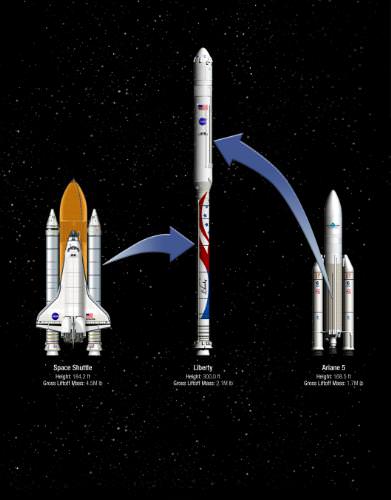
[/caption]
An idea too good to die, or a case of recycle, reuse, reduce? Two rocket companies are joining forces to use part of the Ares-1 rocket and combine it with elements of the Ariane 5 launcher to create a new launch system called Liberty that they say will “close the US human spaceflight gap.” US company ATK (Alliant Techsystems) and the European firm Astrium announced their collaboration today on a 90-meter (300-ft) rocket that would fit under NASA’s Commercial Crew Development-2 (CCDev-2) procurement. The companies say the new rocket could be ready by 2013.
“This team represents the true sense of international partnership in that we looked across borders to find the best for our customers,” said Blake Larson, President of ATK Aerospace Systems Group in a press release. “Together we combine unique flight-proven systems and commercial experience that allows us to offer the market’s most capable launch vehicle along with flexibility to meet a wide variety of emerging needs. Liberty provides greater performance at less cost than any other comparable launch vehicle.”
The partners say Liberty would be much cheaper than the Ares I, because the unfinished upper stage of the Ares I would be replaced with the first stage of the Ariane 5, which has been launched successfully 41 consecutive times. The lower stage of the Liberty, a longer version of the shuttle booster built by ATK, would be almost the same as what was built for Ares-1.

Since both stages were designed for human-rating, the collaborators say this “would enable unmatched crew safety.” The team has planned an initial flight by the end of 2013, a second test flight in 2014, and operational capability in 2015.
Liberty would be able to deliver 20,000 kg (44,500 lbs) to the International Space Station’s orbit, which would give it a launch capability to carry any crew vehicle in development. This is less payload capability, however, than the 25-ton payload that the Ares-1 was advertised to deliver to the ISS.
With the announcement of the collaboration (and quick turn-around) the companies are hoping to be the recipient of some of the $200 million in funding NASA is planning to give out in March 2011 to private companies that are developing space taxis. Smaller NewSpace companies like SpaceX and , Orbital, along with big companies Lockheed Martin and Boeing are all vying for the CCDev-2 contracts.
With some space experts and Congress expressing concern about the length of time it might take for commercial companies to provide reliable transportation to space, as well as concerns about relying on the Russian Soyuz vehicles, this new collaboration could fit NASA’s needs nicely. Plus, the collaborators are hoping the new Liberty rocket will be a bargain compared to other contenders. They are targeting a price of $180 million per launch, which is slightly less than the Atlas V rocket launches by the Boeing-Lockheed Martin United Launch Alliance, ($187 million).
The two companies have touted the new rockets’ ability to carry a wide array of spacecraft and satellites.
“The Liberty initiative provides tremendous value because it builds on European Ariane 5 launcher heritage, while allowing NASA to leverage the mature first stage,” said former NASA astronaut Charlie Precourt, Vice President and General Manager of ATK Space Launch Systems. “We will provide unmatched payload performance at a fraction of the cost, and we will launch it from the Kennedy Space Center using facilities that have already been built. This approach allows NASA to utilize the investments that have already been made in our nation’s ground infrastructure and propulsion systems for the Space Exploration Program.”
If NASA chooses the Liberty system and it works well, it could mean that the money NASA spent on the Ares rocket was not wasted after all.
ATK has put together this video about “Liberty”
Source: ATK
Bigelow Aerospace and Space Florida announce exhibit center
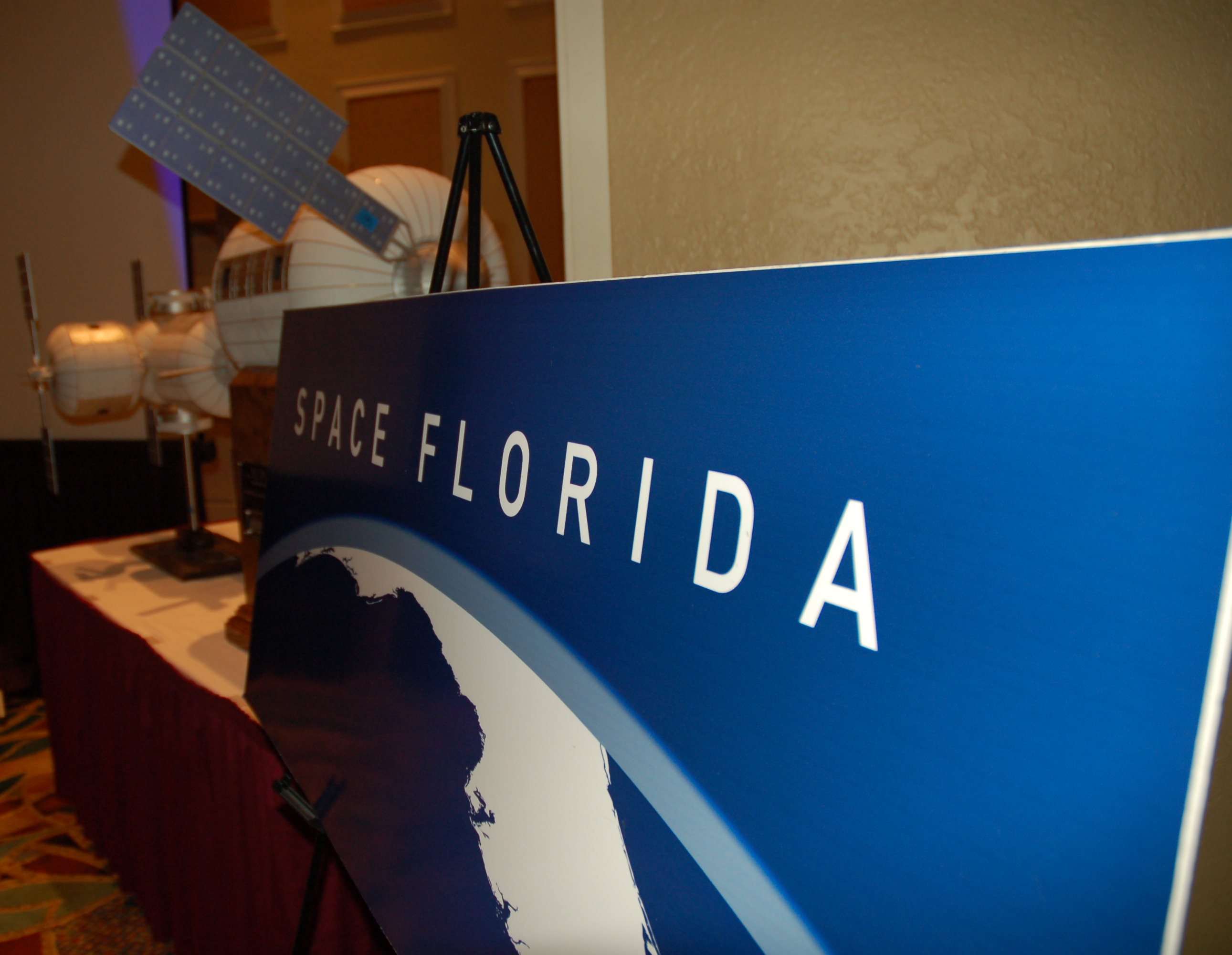
[/caption]
CAPE CANAVERAL – Another NewSpace firm was in the Cape Canaveral area to ink a deal with Florida’s aerospace organization, Space Florida, today. A meeting was held today at the Radisson Resort at the Port to discuss the partnership of Space Florida and Bigelow Aerospace to establish a exhibit center on the Space Coast. Numerous dignitaries and officials in the space industry attended as did elected officials such as Rep. Bill Posey. The brief session started at 1 p.m. EDT and lasted about an hour.
“My purpose by coming here today is to provide a message of hope, that this country is absolutely capable of taking charge of the future of space, not just bequeathing it to other countries and other nations,” said Robert Bigelow founder and president of Bigelow Aerospace at the end of Wednesday’s meeting. “The private sector in this country has the ambition and the chutzpah to go ahead and take this on…”
Space Florida and the commercial space firm inked a deal to build an exhibit center that will showcase one-third scale replicas of Bigelow Aerospace’s inflatable space stations. Two prototypes of which have already been sent into orbit via Russian rockets. The exhibit will primarily be utilized for marketing purposes.
The event was closed with a signing of the Memorandum of Understanding and a brief question and answer session with those in attendance and the media.
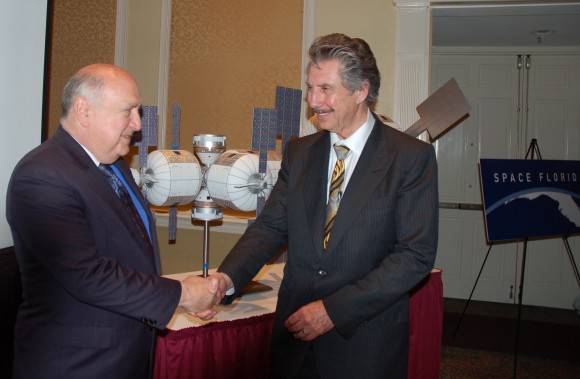
This new effort does however highlight the growing interest of the emerging commercial aerospace market in Florida’s established space infrastructure. Bigelow stated that it was possible that Florida could be the place where much of his firm’s hardware is launched from. However, he mentioned other U.S. launch facilities as well. Approximately 25 flights will be required to make Bigelow’s space station objectives a reality.
“If you think about the process of a country or a major corporation wanting to fly something into space to conduct research, it’s not a simple device that they fly, it is a research program that they find that fits into a multi-year plan,” said Frank DiBello the president of Space Florida. “It is a multi-year project for every one of these customers, we see this as an industry that we are growing – and this is a brick that were placing into the wall of that industry.”
If Florida is selected this could well bring something very valuable back to the Space Coast region of Florida – jobs. These efforts could bring about 1,800 jobs to the area.
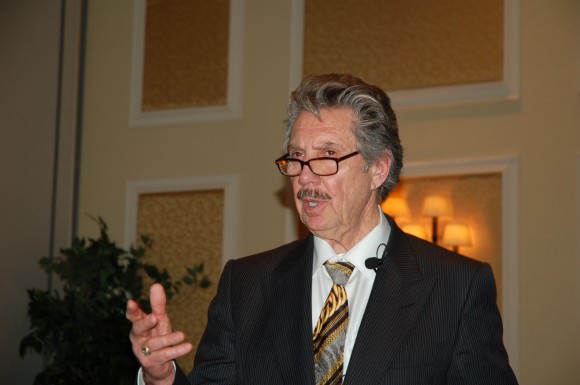
Space Florida is the arm of the State of Florida that is responsible for economic development of aerospace business. The organization was established by the Florida legislature back in 2006 from three separate entities, the Florida Aerospace Finance Corporation, the Florida Space Authority and the Florida Space Research Institute.
Bigelow Aerospace was founded in 1999 and it has since flown two prototypes into space Genesis I and Genesis II which were launched atop a Dnepr ICBM from the Dombarovskiy Cosmodrome in Russia. At the meeting in Cape Canaveral on Wednesday Bigelow stated that one of the main customers that his company is looking at is smaller nations that cannot afford their own space program and would like to send payloads into orbit.
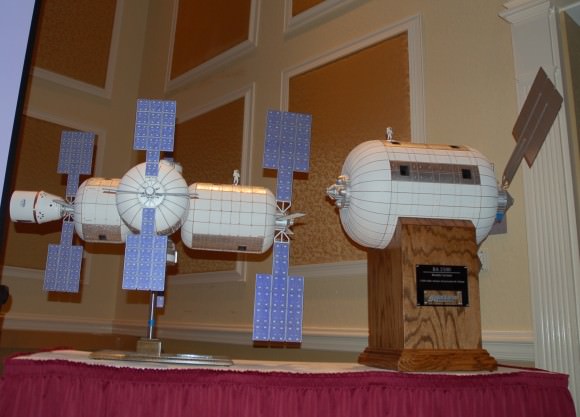
Private Space Company Obtains Old Russian Space Station Modules
[/caption]
The private spaceflight company Excalibur Almaz has obtained two partially completed Almaz space station modules from Russia and brought them to the company’s home base on the Isle of Man. The modules and Excalibur Almaz’ reusable return vehicles were developed by a Russian company in the 1970’s but were never flown. Excalibur Almaz hopes to offer week-long orbital space flights beginning as early as 2013, using the once top-secret Russian capsules and modules.
In 2009, EA reached an agreement JSC MIC NPO Mashinostroyenia (NPOM) of Russia, the company that originally built the spacecraft, and purchased both the Reusable Return Vehicles rockets and modules for the Almaz space station. In the 1970’s, the RRVs went through nine flight tests, with two RRVs flown to orbit several times.
EA will work on updating the spacecraft to conduct crew and cargo space missions for private individuals, corporations, academic institutions and national governments.
In a press release, EA said the stations will be initially stored, followed by research, testing and possibly completion and launch to orbit.
“EA’s initial flights to orbit will be in the flight tested Excalibur Almaz Reusable Return Vehicles joined to and supported by service module living and working habitats,” EA said. “The space stations themselves are part of EA’s long-term business plan. It is not economically feasible to launch and sustain them on orbit until the company’s flight rate reaches six or more flights per year.”
EA Founder and CEO Art Dula said, “This is another significant landmark towards achieving our stated goals with continuing technical support from leading
The Almaz space stations are approximately 11 meters long and four meters in diameter; and are directly related to the module design used on the International Space Station as well as the earlier Russian Salyut and Mir space stations. Other unique features of the Almaz stations include the largest window ever developed for a spacecraft, boasting over two meters of panoramic view of the Earth and stars.
Source: Excalibur Almaz
Map of Future Lunar Landing Sites
Here’s the map of the future: a look where all the contestants in the Google Lunar X PRIZE intend to land on the Moon, in hopes of nabbing the $30 million in prizes available to the first privately funded teams to safely land a robot on the surface of the Moon. Dr. Philip J. Stooke of The University of Western Ontario has put together a this very nifty proposed landing site map based on published data from the Google Lunar X PRIZE Teams. According to Michael Doornbos from the Evadot website, assisting in the visualization, they will be updating the map regularly as the public information gets updated. Click on the image to see the original (and larger version) on Evadot.com
If you remember, the participants in the Google Lunar X PRIZE not only have to land their robot, but it also has to travel 500 meters over the lunar surface and send images and data back to the Earth. Teams must be at least 90% privately funded. The GLXP hopes to ignite a new era of lunar exploration by offering this largest international incentive prize of all time.
Find out more at The Google Lunar X PRIZE Website

